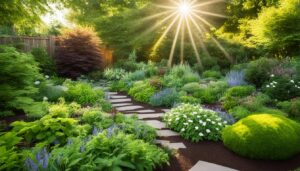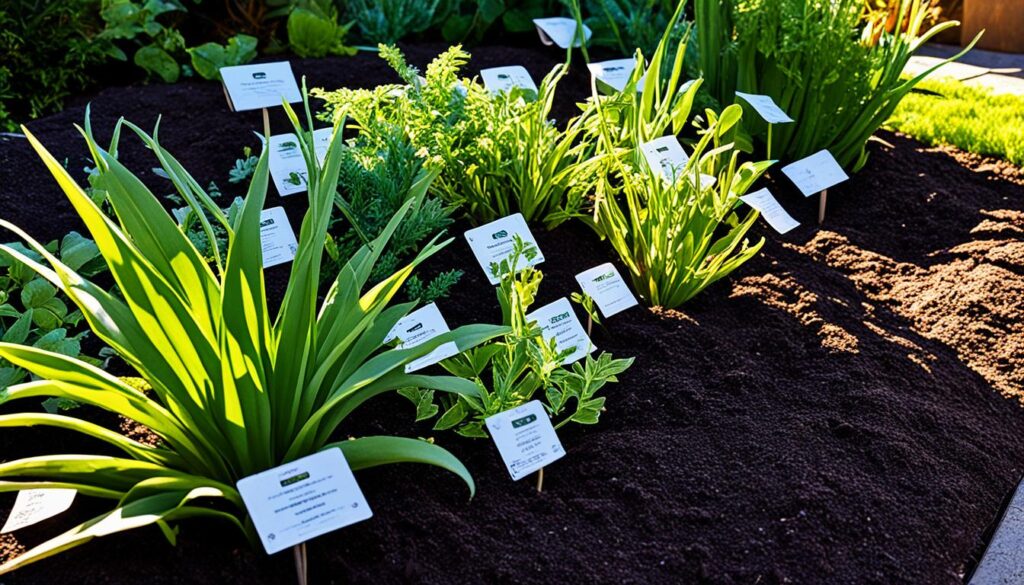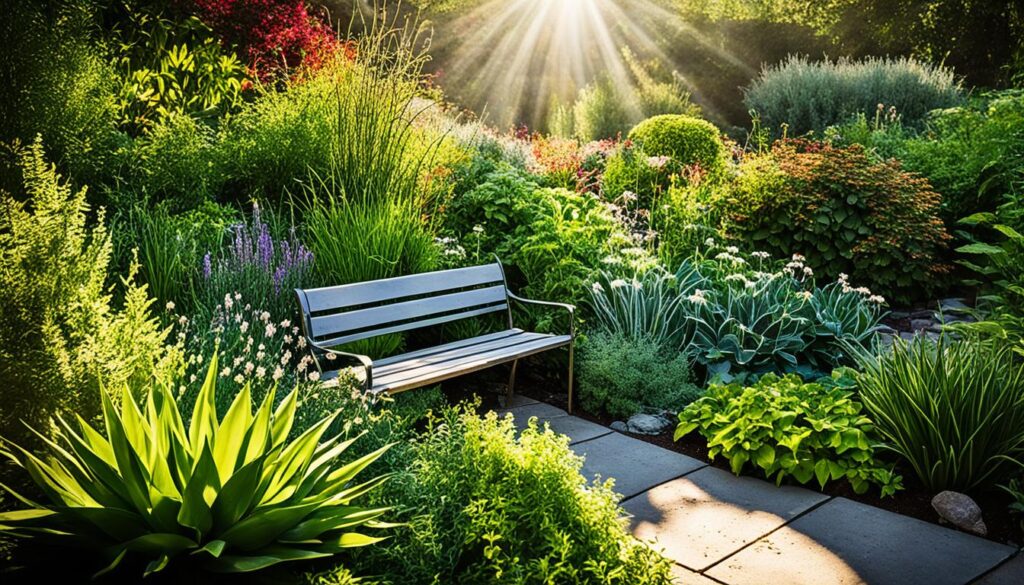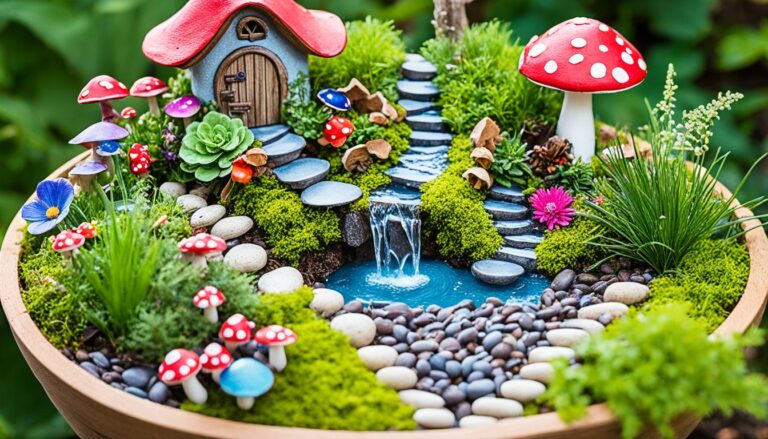How much sun does a Garden need? For gardeners new and old, knowing the optimal sunlight for plants is key. Each type of plant needs a different amount of light to grow well. This makes gardening like a dance, matching each plant’s need with the amount of sunlight it gets.
Knowing the right sunlight duration for gardening is crucial. Just as an artist uses color, a gardener uses light. Understanding plant sunlight needs turns a patch of earth into a vibrant garden.
Key Takeaways
- How much sun does a Garden need? Recognize that the right amount of sunlight is crucial for plant growth and development.
- Identify and match plants to their labeled sunlight needs: full sun, part sun, part shade, full shade.
- Remember, morning sunlight is gentler and beneficial for part sun and part shade plants.
- Full shade plants prosper in filtered light or dappled shade and should avoid intense mid-day sun.
- Adjusting to local conditions is key to aligning plants with the sunlight they require for optimal growth.
- Track the seasonal sunlight in your garden, starting from spring, to understand variations in light exposure.
Understanding Sunlight Terms for Garden Plants
To grasp the garden sunlight requirements, you must learn the language found on plant tags. They’re divided into groups based on how much sun exposure for gardens they need: full sun, part sun, part shade, and full shade. This language helps gardeners choose the right plants for the amount of sunlight their garden gets.
Plants that thrive in full sun need at least six hours of direct light each day. This amount of light is very important for their development. On the other hand, part sun and part shade plants need three to six hours of sunlight. Part shade plants are not good with direct, strong sunlight and need some protection. Full shade plants do well with less than three hours of sun daily.
It’s crucial to know these terms for gardening success. It makes certain that plants receive the right amount of sunlight for their growth. For more detailed information, you might want to explore botanical gardens or top gardening sites like Better Homes & Gardens.
| Category | Sunlight Needed | Examples |
|---|---|---|
| Full Sun | 6+ hours | Most garden veggies, roses |
| Part Sun/Part Shade | 3-6 hours | Begonia, lungwort |
| Full Shade | <3 hours | Ferns, hellebore |
Successful gardening means matching the available sun exposure for gardens with what each plant needs. This harmony between our garden’s sunlight and the plants’ requirements is crucial for their success.
How Much Sun Does a Garden Need: Decoding Plant Labels
When you start planning a garden, knowing the right sun conditions for plants is key. This includes understanding what “full sun” or “part shade” mean. Plant labels are vital tools. They help gardeners choose the best spots for their plants based on their sunlight needs.
Full Sun and Its Variations
Plants labeled for full sun need about 6 to 8 hours of direct sunlight daily. However, this can vary based on where you live. Things like how high up you are or how close you are to big water sources can impact sunlight. Learning more about decoding plant labels is great for taking good care of your plants.
Part Sun vs. Part Shade
There is a difference between ‘part sun’ and ‘partial shade’. Part sun plants like 4 to 6 hours of sunlight each day, but they want it when it’s not too hot. In comparison, partial shade plants also need 4 to 6 hours of light, but they can’t handle the scorching heat of direct afternoon sun. This difference is important, especially in places with very sunny afternoons.
Navigating Full Shade in Your Garden
For places that get less than 3 hours of direct sun, full shade plants are perfect. They do well under big trees or on the north side of buildings. Here, the sun is not direct. Knowing which plants like full shade can keep your garden healthy. This way, you avoid plants getting too much sun.
Picking the right plants for the amount of sun your garden gets is essential. It’s not only about looks but also about helping them grow well. If you have a small balcony or a big backyard, it’s important to match the plants’ needs with the sunlight you have. This makes for a beautiful, lively garden.
Looking closely at plant labels and what they say about sun needs helps make good garden plans. It’s a way to blend your style with what your plants need to be healthy.
Assessing Sun Exposure: A Data-Driven Approach
Knowing how much sun your plants need is key for their health and growth. Sunlight necessity in gardening is a must-know. Using data to check your garden’s sun is very helpful. This helps you give your plants the right amount of light they need.
Some veggies need about eight hours of sun daily. Yet, each plant type does well in its own light; from full sun to deep shade. Checking how much sun your garden gets is a must.
- Using digital cameras, tripods, and editing software can help you track sunlight details.
- Apps like Sun Surveyor or Sun Seeker offer accurate sun path tracking for a small fee.
- Physical tools like the Solar Pathfinder or sunlight calculators can measure sunlight directly.
Plants also care about the weather, like how hot or cold it is, how humid, and the wind. So, you should look at what kind of weather your garden gets, from sunny spots to shady ones.
Planning how to place your garden for the most sunlight is a big deal. You need to look at your place, see what your plants need, and design a plan that fits them well.
Your garden’s look should match your home’s style, be it French, Spanish, or Oriental. This way, your garden gets the right light in a beautiful way.
Positioning Your Plants for Perfect Sunlight Levels
To make your garden flourish, knowing how to position your plants in the right sunlight is key. It’s about finding the best sunlight for different plants and changing your garden’s setup as the sun moves during the year.
Matching Plants to Garden Light Conditions
Pairing each plant with its ideal light is crucial for a lively garden. Vegetables like tomatoes and zucchinis need lots of direct sun, while leafy greens can make do with less. It’s important to observe your garden’s sunlight patterns to keep all plants happy.
Adjusting Garden Layout for Seasonal Sunlight Changes
The sun’s angle changes by season, affecting how your garden gets light. Summer’s light is better for plants that love the sun. In contrast, winter may need you to move these plants to keep them sunny all day.
In planning for the seasons, think about more than just where the plants go. Moveable planters or adjustable garden beds can help during winter when sunlight is less. Also, consider how the sun’s path interacts with objects that might shadow your plants.
Tools like SunCalc can be very useful for understanding sunlight in your garden. With this knowledge, you can place your garden items strategically for the most sunlight. This is vital for both food and beautiful plants to grow strong.
A garden does well when it changes with the seasons. By carefully planning where each plant goes, depending on the light they need, your garden can thrive all year round.
Optimal Sunlight for Plants: Creating a Sunlight Map
Mapping sunlight is key to knowing how to meet plants’ garden sunlight needs. This method follows the sun’s path, making sure every plant gets the right amount of light. It helps gardeners know where to plant based on the amount of sun different plants need.
To start, you watch and write down where the sun shines in your garden at specific times. This is usually done at 9:00 am, 12:00 pm, 3:00 pm, and 6:00 pm. Summer is the best time for this since days are long, giving a clear view of the sun’s path.
- Full sun plants need more than 6 hours of direct sun and do well in open spots.
- Part sun and part shade plants like 3-6 hours of light, but those in part shade need some protection from harsh afternoon sun.
- Full shade plants grow best in spots with less than 3 hours of direct sun, often under big trees or structures.
Use flags or markers to show where the sun hits best. This creates a clear map showing the best spots for each type of plant.
| Time of Day | Full Sun Area | Part Sun Area | Full Shade Area |
|---|---|---|---|
| 9:00 AM | East Garden Bed | South-Eastern Corner | North Side |
| 12:00 PM | Central Garden | Western Edge | Under Large Oak |
| 3:00 PM | West Garden Bed | South-Western Corner | Eastern Pathway |
| 6:00 PM | North-Western Edge | Central Garden | Covered Pergola Area |
Getting the sunlight right helps plants to be healthy and beautiful. It makes the most of your garden space. Knowing the sun needs of your plants leads to a better garden design. Each plant gets the perfect light it needs to grow well.
Garden Design for Varying Sunlight Duration
Creating a garden ready for different levels of sunlight is key. It takes knowing the ideal sun exposure for gardening and garden light conditions. With this knowledge, garden plans can fit everything from sun-loving plants to those that prefer the shade. This makes a garden both beautiful and sustainable.
Designing Gardens with Full Sun in Mind
In sunny spots, choosing plants that love the sun is very important. These plants need at least 6 hours of direct sunlight daily. They can be from various species, adding vibrant colors to your garden. Plants that like heat and don’t need much water do well in these bright conditions.
Choosing Plants for Shady Areas
Shaded areas can be just as beautiful as sunny ones. Some plants do great with less than 3 hours of direct sun. This understanding helps pick the right plants for different shade levels. For example, begonias and impatiens bloom under trees or in the north, giving life to these spaces.
Designed thoughtfully, a garden can fit all kinds of light needs. It transforms any area into a beautiful, colorful space. This happens by working with the available sunlight all day long.
Sunlight Necessity in Gardening: Adapting to Regional Differences
Knowing what sunlight your garden needs is key for it to thrive. Gardens in different parts of the world get different amounts of sun. This means gardeners must adjust their strategies to best suit their garden’s needs.
Sun Exposure in Different Climatic Zones
Places like the Southern U.S. get a lot of sun, but it’s very hot. Plants there often need some shade to stay healthy. On the other hand, the Pacific Northwest is cooler and cloudier. It’s harder for sun-loving plants.
Cacti and succulents need lots of sun, like they get in arid areas. They need about 10 hours of sun every day. Yet, in places that are cooler and often cloudy, these plants may need extra light to grow well.
The Pacific Northwest is known for cloudy days. This weather makes it tough for plants that love the sun. However, it’s perfect for plants that do well in the shade, like ferns and hostas. These plants grow best under trees or in areas with a bit of shade.
Managing Sunlight for Heat-Sensitive Varieties
Some plants are very sensitive to heat and light. For them, getting the right amount of sun is crucial. They need morning light and shade in the hot afternoons. This helps them stay strong and grow well.
Placing taller plants or structures in your garden can help. They can create shade where needed. This way, you can make sure your garden’s plants get the perfect amount of sun.
Overall, tailoring your garden to the sunlight it gets is critical. It ensures your plants can thrive. Every area comes with its own set of challenges and joys for gardening.
Ideal Sun Exposure for Gardening: The Role of Structures and Nature
In a garden, natural elements and built structures greatly affect how much sunlight plants get. These affect the amount needed for plants to thrive. They make the area look nice but also help control the light.
Maximizing Sunlight Through Limbing Up and Thinning Canopies
Gardeners can improve sunlight by cutting back trees. They do this by removing lower branches or thinning out leaves. This lets more light reach the ground, perfect for plants that love the sun. It not only helps the garden but the trees too, making them healthier and better looking.
Utilizing Fences and Lattices to Modulate Sunlight
Fences and lattices are useful in many ways in a garden. They can protect some plants from too much sun. Plus, they provide support for climbing plants. A good lattice can filter the sun, giving the right amount to various plants. This way, a garden can host many types of plants together.
Gardening includes careful planning to use natural light well. It’s about creating the perfect conditions for plants to grow. This can be learned more by reading guides, like the one about planting in sun or shade.
By applying these ideas, gardeners can improve their garden’s health and looks. They can control sunlight, using the environment’s features and man-made items. This creates the best conditions for plants, leading to a beautiful garden.
Conclusion
How much sun does a Garden need? Exploring how plants interact with sunlight teaches us a lot about gardening. Understanding how much sun a garden needs involves looking at various environmental clues. The key to a successful garden is matching the right amount and type of light to each plant’s needs.
The USDA Hardiness Zone map helps us see the climate challenges in each area, like Oklahoma’s range from zone 6a to zone 8a. This map shows the importance of knowing your region’s weather. It helps in giving plants the best sunlight possible.
Using the USDA and American Horticultural Society’s data can improve gardening results. It helps gardeners give the right amount of light to sun-loving and delicate plants. When setting up your garden, consider things like where the sun shines or how to protect plants from too much light. This knowledge is key to success.
To wrap up, using information to plan for sunlight is crucial for gardening. It’s about more than just making sure plants get light. It’s about using light in clever ways to help plants grow well. This approach turns gardeners into artists, making beautiful, lively places with the power of sunlight.













